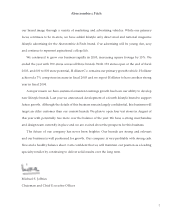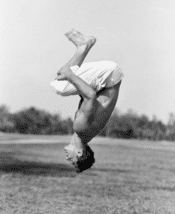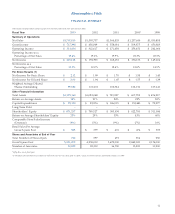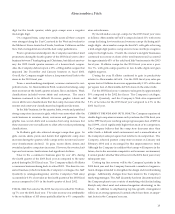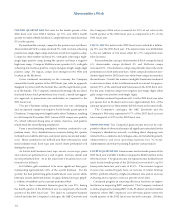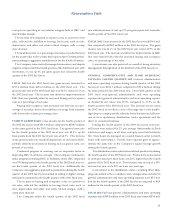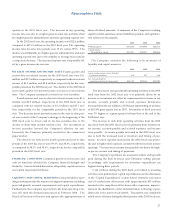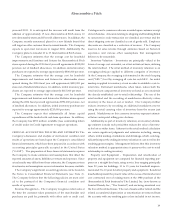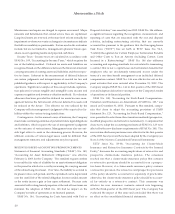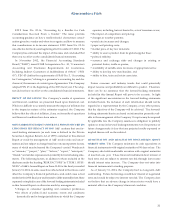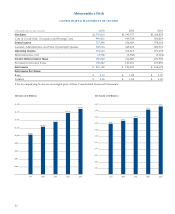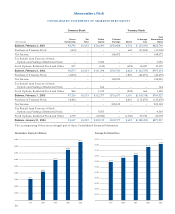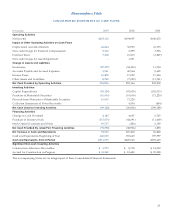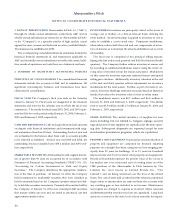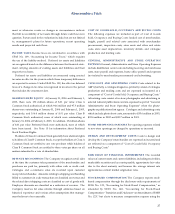Abercrombie & Fitch 2003 Annual Report Download - page 19
Download and view the complete annual report
Please find page 19 of the 2003 Abercrombie & Fitch annual report below. You can navigate through the pages in the report by either clicking on the pages listed below, or by using the keyword search tool below to find specific information within the annual report.
quarter in the 2001 fiscal year. The increase in the operating
income rate was due to a higher gross income rate partially offset
by a higher general, administrative and store operating expense rate.
In the 2002 fiscal year, the operating income was $312.6 million
compared to $271.5 million in the 2001 fiscal year. The operating
income rates for same time periods were 19.6% versus 19.9%. The
decline was attributable to a higher general, administrative and store
operating expense rate due to the inability to leverage fixed costs on
a comp store decrease. The increased expense rate was partially off-
set by a gross income rate increase.
INTEREST INCOME AND INCOME TAXES Fourth quarter and
year-to-date net interest income for the 2003 fiscal year were $1.1
million and $3.7 million, respectively, as compared with net interest
income of $1.3 million and $3.8 million, respectively, for the com-
parable periods in the 2002 fiscal year. The decline in the 2003 fiscal
year fourth quarter net interest income was due to lower interest
rates. The Company continued to invest in tax-free securities.
Fourth quarter and year-to-date net interest income were $1.3
million and $3.8 million, respectively, in the 2002 fiscal year as
compared with net interest income of $1.2 million and $5.1 mil-
lion, respectively, for the comparable periods in the 2001 fiscal
year. The decrease in net interest income in the year-to-date peri-
od was a result of the Company’s strategy, at the beginning of the
2002 fiscal year, to invest cash in tax-free securities due to the
decline in short-term market interest rates. The investment in
tax-free securities lowered the Company’s effective tax rate.
Previously, the Company primarily invested in the commercial
paper market.
The effective tax rates for the fourth quarter and year-to-date
periods of the 2003 fiscal year were 39.3% and 38.8%, respectively,
as compared to 38.5% and 38.4%, respectively, for the comparable
periods in the 2002 fiscal year.
FINANCIAL CONDITION Continued growth in net income and
cash on hand has afforded the Company financial strength and
flexibility. A more detailed discussion of liquidity, capital resources
and capital requirements follows.
LIQUIDITY AND CAPITAL RESOURCES Cash provided by oper-
ating activities provides the resources to support operations, including
projected growth, seasonal requirements and capital expenditures.
Furthermore, the Company expects that cash from operating activ-
ities will fund the dividend announced in February 2004. The
Board of Directors will review and approve the appropriateness of
future dividend amounts. A summary of the Company’s working
capital (current assets less current liabilities) position and capitaliza-
tion follows (in thousands):
2003 2002 2001
Working capital $472,653 $384,094 $241,616
Capitalization:
Shareholders’ equity $871,257 $749,527 $595,434
The Company considers the following to be measures of
liquidity and capital resources:
2003 2002 2001
Current ratio (current assets divided
by current liabilities) 2.69 2.57 2.48
Net cash provided by
operating activities (in thousands) $281,896 $293,146 $233,202
The decrease in cash provided by operating activities in the 2003
fiscal year from the 2002 fiscal year was primarily driven by an
increase in inventories not offset by commensurate increases in net
income, accounts payable and accrued expenses. Inventories
increased from the net addition of 103 stores representing an increase
of 663,000 gross square feet in 2003. Inventories at fiscal year-end
were 3% higher on a gross square foot basis than at the end of the
2002 fiscal year.
The increase in cash from operating activities from the 2002
fiscal year from the 2001 fiscal year was primarily from increases in
net income, accounts payable and accrued expenses, and income
taxes payable. Accounts payable increased in the 2002 fiscal year
due to both the increased level of inventory and timing of pay-
ments. Accrued expenses increased in the 2002 fiscal year prima-
rily due to higher store expenses, consistent with the increase in store
openings. The increase in income taxes payable was driven by high-
er pre-tax income and timing of payments.
The Company’s operations are seasonal in nature and typically
peak during the back-to-school and Christmas selling periods.
Accordingly, cash requirements for inventory expenditures are
highest during these periods.
Cash outflows during the 2003 fiscal year related to investing
activities were primarily for capital expenditures (see the discussion
in the “Capital Expenditures” section below) related to new stores
(net of construction allowances) with approximately $35 million
invested in the completion of the home office expansion, improve-
ments in the distribution center and information technology expen-
ditures for a new point-of-sale system. This system was completely
rolled-out to all stores during the third quarter of the 2003 fiscal year.
Abercrombie &Fitch
17


